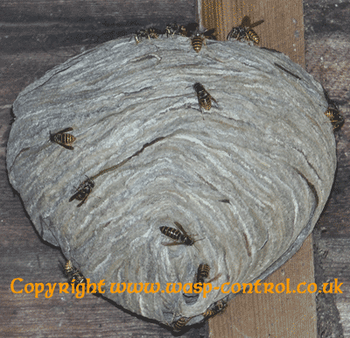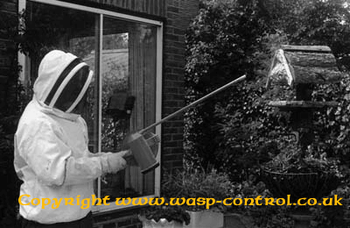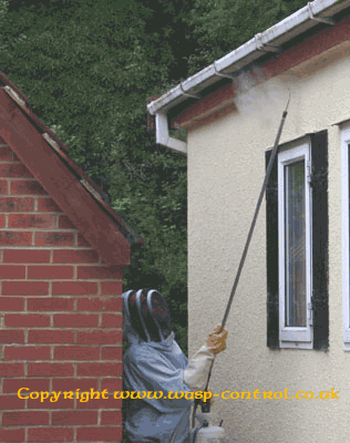Wasp nest removal
Is it necessary to remove a treated wasp nest?
In certain instances, removing a wasp nest becomes essential if the nest obstructs an entrance or poses an immediate risk to public safety. However, when dealing with a wasp nest in a standard location, such as your loft, there are compelling reasons to consider leaving the treated nest in its current position.
Once all the wasps are eliminated, the nest no longer poses a threat. It serves as a structure created by the wasps through wood chewing for their seasonal habitation.
Treatment with professional-use insecticides like bendiocarb or permethrin leaves residual dust in the nest with a reasonable shelf life, ready to intercept potential intruders. Frequently, after treatment, neighboring wasps attempt to raid the now undefended nest. As these "scavenging" wasps enter, they come into contact with the dust and perish, turning the treated nest into a hazard for wasps from other colonies.
Leaving the nest undisturbed provides strategic benefits. During spring, when queen wasps emerge from winter hibernation and explore potential nesting sites, they might encounter the treated nest. There's a high likelihood that these queens will investigate the treated nest and succumb to the dust, preventing them from building a new nest.
Our recommendation is to opt for wasp nest removal only when the nest genuinely poses a problem or obstruction. The majority of nests can be effectively treated and left in place without further disturbance, ensuring a more nuanced approach to pest management.


How long does wasp nest removal take?
If you need to remove a wasp nest, the recommended approach is to treat the nest first. After allowing time for any foraging wasps to return and succumb to the insecticide, the actual removal process can be initiated.
It's important to note that the removal of the wasp nest won't happen on the same day as the treatment, as it requires a separate step for all foraging wasps to die off. Some pest controllers may charge an additional fee for the subsequent removal, so it's advisable to clarify their charges before availing their services.
When a wasp nest is treated with a quick knockdown method, such as a wasp nest foam treatment, and is immediately removed, surviving foraging wasps may return to the original location, leading to potential complications. In some cases, these surviving wasps may even start rebuilding a new nest from scratch after the original nest is treated and removed using rapid treatment methods.
If you're contemplating nest removal, discuss this with your local wasp controller to determine the most suitable solution for your needs.
In the case of a wasp nest treated with Ficam D, it is recommended to leave the treated nest for at least 24 hours before attempting removal. This precaution is taken to avoid contact with any live wasps that may have been away from the nest during treatment and returned afterward. Some foraging wasps may not return to the nest daily, and occasionally a few might arrive the day after treatment. It's not uncommon for some wasps to spend nights in sheds or houses after a day of hunting for food.
If you choose to remove a wasp nest yourself, ensure it is unoccupied before attempting removal. If unsure, avoid touching or removing the nest, as even the slightest vibrations can provoke wasps into attacking. When certain that the nest is unoccupied, wear gloves, use a bin liner to enclose the nest, and seal it tightly before disposing of it in the waste bin. The nest is typically made from a thin paper mache material, making it easy to break apart, while the core (comb part) is somewhat more resilient but can be detached without much effort.

FAQ'S
- Do I have to be out of the house when the nest is removed?
- No, you don't have to leave your house during nest removal. The nest will be treated before removal, ensuring all wasps are dead, making it safe to stay indoors.
- Do I need to remove a wasp nest which is outside?
- No, there is no need to remove an outside wasp nest. It won't be reused and will naturally degrade over time.
- Can I remove a wasp nest which is underground?
- Yes, you can remove an underground wasp nest, but it should be treated first. After the wasps are eliminated, you can dig it up and dispose of it.
- Will the pest controller need me to provide any equipment to remove a wasp nest?
- No, the removal process is straightforward. It involves breaking the nest apart and placing it into a bin bag. No additional equipment is required from your end.
- Does a wasp nest cause any damage to my house?
- Yes, a wasp nest can cause property damage. If located on top of a plasterboard ceiling, the nest can become damp over time, leading to the softening and eventual collapse of the plasterboard. Wasps may also chew materials, such as plasterboard walls, near the nest for expansion purposes.